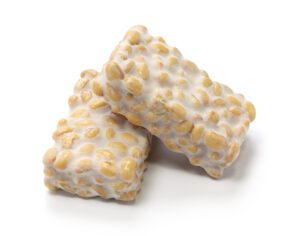Until recently, it was considered that soybeans originated in either Siberia, China, the Korean Peninsula or Southeast Asia. New archaeological excavations and genetic studies have revealed characteristics that are unique to soybeans in each region, which suggests that the the origina of the soybean may have been in more than one place.
The ancestor of the modern soybean is a vine-like plant known as the wild soybean (Glycine soja; called Tsuru-mame or no-mame in Japan).

This plant can still be found throughout Japan, as far north as the Hidaka region of Hokkaido, which is the northernmost island of Japan. The vine of the wild soybean has a long, thin stem, and the bean is rounder and smaller than the modern soybean. Over its long history as a cultivated crop, the bean has grown larger and the stems have become shorter and the soy plant has evolved from a vine-like to upright plant. The pods containing the beans have also lost their natural tendency as leguminous plants to break off when ripe.
Intermediates between soybean and wild soybean have also been found in the regions mentioned above, indicating that the soybean found throughout the world today is not the same as the ancient soybean that evolved through cultivation in China and East Asia. There are specific references to the cultivation of soybeans in the oldest Chinese agricultural text, “Fan Shengzhi’s Manual” (late 1st century BCE), which describes agriculture in what is now Shanxi Province. This work states that “Soybeans can be easily harvested even in a poor harvest year. It was therefore natural for our ancestors to grow soybeans as a reserve crop for times of famine.” (The original text of the Fan Shengzhi Manual for Agriculture has been lost, but some parts are quoted in other later Chinese texts.)
Soybeans were originally cultivated and eaten only in Asia
Among the places where soybeans originated, the strongest evidence of their historical cultivation comes from the Zhou Dynasty in China (from 11th century BCE). Soybean production had already expanded during the Zhou Dynasty to encompass three regions—the Northeast, the Yellow River basin, and the Yangtze River basin—using cultivation methods suited to each region’s climate. In the Northeast, which was the largest area of production, soybeans were cultivated in rotation with grains. In the Yellow River basin, soybeans were cultivated as an annual crop in the north and following wheat cultivation in the south. Many documents from 4th century BCE China record that soybeans were used as a staple food together with millet.
The oldest records of soybean cultivation and use on the Korean peninsula date from the middle of the 3rd century BCE, but there was already exchange with China at this time, so presumably the Korean people had already been familiar with the soybean for a long time.
Soybeans were first mentioned in Japan in the Kojiki (Record of Ancient Matters; compiled in 712) and Nihon Shoki (Chronicles of Japan, compiled in 720), but soybeans have been excavated from several Yayoi period sites (300 BCE – 240 CE), suggesting that they may have been cultivated and used before the Common Era. Both the Kojiki and Nihon Shoki mention the soybean as one of the five ancient grains of Japan, and even include a myth that Ohgetsuhime, the goddess of the five grains, gave soybeans to the god Susano-no-mikoto.
In India, Nepal, and Indonesia, we know that fermented soybean foods such as tempeh and kinema (fermented soy beans similar to Japanese natto) have been consumed since ancient times, although there are no written records of this.
 .
. 
This is part 1 of a series looking at the history of soy that was prepared and previously published by Fuji Oil Japan Ltd.
Interested to read more?
Take a look at this article: “New technologies create new functionality in okara (soy bean curds)”
